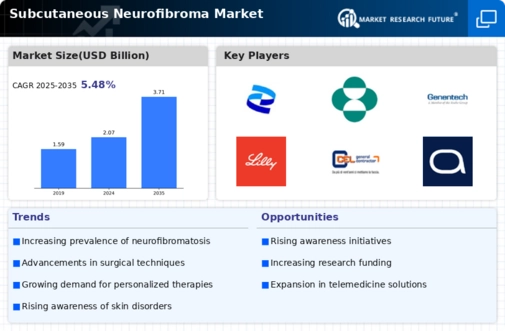Rising Awareness and Advocacy Efforts
Rising awareness and advocacy efforts surrounding neurofibromatosis are playing a pivotal role in shaping the Subcutaneous Neurofibroma Market. Organizations dedicated to educating the public and healthcare professionals about the condition are increasing visibility and understanding of neurofibromatosis. This heightened awareness is likely to lead to earlier diagnoses and prompt treatment, which could positively impact patient outcomes. Furthermore, advocacy groups are pushing for more research funding and better access to care, which may stimulate market growth. As awareness continues to rise, the Subcutaneous Neurofibroma Market is expected to expand in response to the growing demand for effective treatment options.
Emerging Trends in Personalized Medicine
Emerging trends in personalized medicine are significantly influencing the Subcutaneous Neurofibroma Market. The shift towards tailored treatment approaches, which consider individual genetic profiles, is becoming increasingly prevalent. This trend is particularly relevant for conditions like neurofibromatosis, where genetic factors play a crucial role in disease manifestation. Personalized therapies that target specific genetic mutations associated with neurofibromas are being developed, potentially leading to more effective and less invasive treatment options. As the field of personalized medicine continues to evolve, it is likely to drive innovation and growth within the Subcutaneous Neurofibroma Market.
Increasing Incidence of Neurofibromatosis
The rising incidence of neurofibromatosis, particularly type 1, is a notable driver for the Subcutaneous Neurofibroma Market. Recent estimates suggest that neurofibromatosis affects approximately 1 in 3,000 individuals, leading to a growing patient population requiring treatment. This increase in prevalence is likely to stimulate demand for therapeutic options, including surgical interventions and pharmacological treatments. As awareness of the condition expands, healthcare providers are more frequently diagnosing neurofibromatosis, which may further contribute to market growth. The need for effective management strategies for subcutaneous neurofibromas is becoming increasingly apparent, thereby propelling the Subcutaneous Neurofibroma Market forward.
Growing Investment in Research and Development
Growing investment in research and development is a critical driver for the Subcutaneous Neurofibroma Market. Pharmaceutical companies and research institutions are increasingly allocating resources to explore new treatment options and understand the underlying mechanisms of neurofibromatosis. This trend is evidenced by the rise in clinical trials focused on innovative therapies, with a notable increase in funding for studies aimed at developing effective treatments for subcutaneous neurofibromas. As more breakthroughs are achieved, the market is likely to witness an influx of new products, thereby enhancing the overall landscape of the Subcutaneous Neurofibroma Market.
Technological Advancements in Treatment Modalities
Technological advancements in treatment modalities are significantly influencing the Subcutaneous Neurofibroma Market. Innovations in surgical techniques, such as minimally invasive procedures, have improved patient outcomes and reduced recovery times. Additionally, the development of targeted therapies and novel pharmacological agents is enhancing treatment efficacy. For instance, the introduction of specific inhibitors that target the molecular pathways involved in neurofibroma growth is showing promise in clinical trials. These advancements not only improve the quality of care but also expand the therapeutic options available to patients, thereby driving the growth of the Subcutaneous Neurofibroma Market.

















Leave a Comment